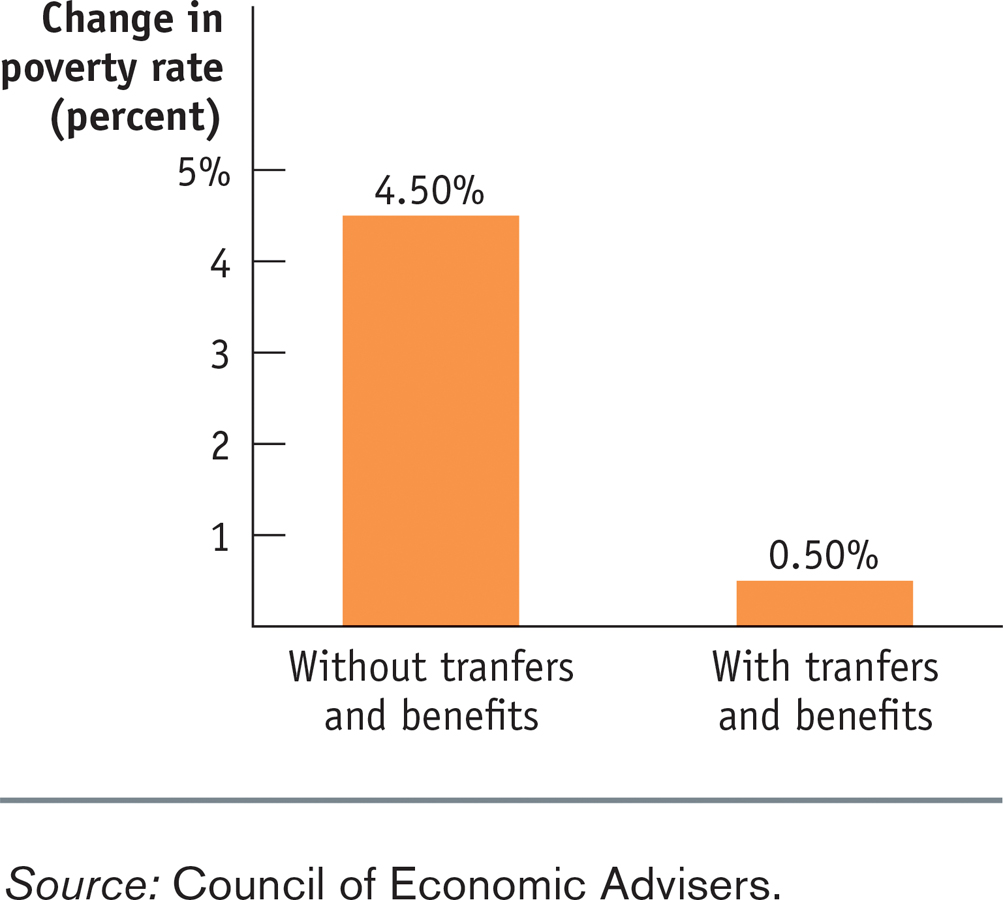The Effects of the Welfare State on Poverty and Inequality
Because the people who receive government transfers tend to be different from those who are taxed to pay for those transfers, the U.S. welfare state has the effect of redistributing income from some people to others. Government statisticians have put considerable effort into calculating the effects of this redistribution, which makes a big difference to poverty rates and a somewhat smaller difference to overall inequality. A caveat: such reports calculate only the direct effect of taxes and transfers, without taking into account changes in behavior that the taxes and transfers might cause. For example, they don’t try to estimate how many older Americans who are now retired would still be working if they weren’t receiving Social Security checks. As a result, the estimates are only a partial indicator of the true effects of the welfare state. Nonetheless, the results are striking.
Table 18-4 shows how a number of government programs affected the poverty rate, as measured by the Supplemental Poverty Measure, for the population as a whole and for different age groups in 2012. For each program it shows the amount, in percentage points, by which that group’s poverty rate was reduced by the program. For example, it says that without Social Security, the poverty rate among older Americans would have been almost 40 percentage points higher than it was.
|
|
All People |
Children |
Nonelderly Adults |
65 Years and Older |
|---|---|---|---|---|
|
Social Security |
8.56% |
1.97% |
4.08% |
39.86% |
|
Refundable Tax Credits |
3.02 |
6.66 |
2.25 |
0.20 |
|
SNAP (Food Stamps) |
1.62 |
3.01 |
1.27 |
0.76 |
|
Unemployment insurance |
0.79 |
0.82 |
0.88 |
0.31 |
|
Supplemental Security Income |
1.07 |
0.84 |
1.12 |
1.21 |
|
Housing Subsidies |
0.91 |
1.39 |
0.66 |
1.12 |
|
School lunch |
0.38 |
0.91 |
0.25 |
0.03 |
|
Temporary Assistance for Needy Families |
0.21 |
0.46 |
0.14 |
0.05 |
|
WIC |
0.13 |
0.29 |
0.09 |
0.00 |
|
Source: Council of Economic Advisers. |
||||
|
Quintiles |
Share of aggregate income without taxes and transfers |
Share of aggregate income with taxes and transfers |
|---|---|---|
|
Bottom quintile |
2.5% |
5.1% |
|
Second quintile |
7.3 |
9.2 |
|
Third quintile |
12.2 |
14.0 |
|
Fourth quintile |
19.0 |
19.9 |
|
81st- |
38.6 |
35.6 |
|
Top 1 percent |
21.3 |
17.1 |
|
Source: Congressional Budget Office. |
||
Table 18-5 shows a Congressional Budget Office estimate of the effect of taxes and transfers on the share of aggregate income going to each quintile of the income distribution in 2007 (the latest available date). The effect of government programs was to increase the share of income going to the poorest 80% of the population, especially the share going to the poorest 20%, while reducing the share of income going to the richest 20%.
ECONOMICS in Action: Welfare State Programs and Poverty Rates in the Great Recession, 2007-
Welfare State Programs and Poverty Rates in the Great Recession, 2007-
In 2007 the U.S. economy entered a deep downturn, the worst I since the 1930s. Recovery officially began in 2009, but it was slow and disappointing. As of 2013 both average and median family income, adjusted for inflation, were still well below their 2007 levels.

Given this poor economic performance, you might have expected to see a sharp rise in poverty, and the official poverty rate did in fact move up, as you can see in Figure 18-1. But while the Great Recession and its aftermath certainly hurt many American families, the country never seemed as desperate as it did during the Great Depression, or even during the last big slump, in 1981–
The main answer, it turns out, was antipoverty programs, which automatically expanded during the slump and were further reinforced by legislation that temporarily expanded food stamps and other forms of aid. Figure 18-4 shows an estimate of how much the poverty rate would have risen between 2007 and 2010 in the absence of welfare state programs, compared with how much it actually rose. Without transfers and benefits the poverty rate would have risen by 4.50%; but with transfers and benefits it rose only 0.50%. The U.S. welfare state didn’t prevent the slump, or stop many people from losing their jobs and some from losing their houses. But it did strikingly limit the rise in poverty.
Quick Review
Means-
tested programs are designed to reduce poverty, but non- means- tested programs do so as well. Programs are classified according to whether they provide monetary or in- kind benefits. “Welfare,” now known as TANF, is far less generous today than a generation ago due to concerns about its effect on incentives to work and family breakup. The negative income tax addresses these concerns: it supplements the incomes of only low-
income working families. Social Security, the largest program in the U.S. welfare state, is a non-
means- tested program that provides retirement income for the elderly. It provides a significant share of the income of most elderly Americans. Unemployment insurance is also a key social insurance program that is not means- tested. Overall, the American welfare state is redistributive. It increases the share of income going to the poorest 80% while reducing the share going to the richest 20%.
18-2
Question 18.5
Explain how the negative income tax avoids the disincentive to work that characterizes poverty programs that simply give benefits based on low income.
Question 18.6
According to Table 18-4, what effect does the U.S. welfare state have on the overall poverty rate? On the poverty rate for those aged 65 and over?
Solutions appear at back of book.